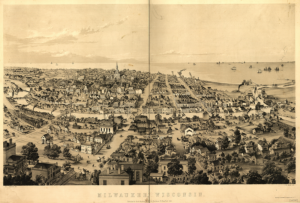[wr_row width=”boxed” background=”none” solid_color_value=”#FFFFFF” solid_color_color=”#ffffff” gradient_color=”0% #FFFFFF,100% #000000″ gradient_direction=”vertical” repeat=”full” img_repeat=”full” autoplay=”yes” position=”center center” paralax=”no” border_width_value_=”0″ border_style=”solid” border_color=”#000″ div_padding_top=”10″ div_padding_bottom=”10″ div_padding_right=”10″ div_padding_left=”10″ ][wr_column span=”span12″ ][wr_text text_margin_top=”0″ text_margin_bottom=”0″ enable_dropcap=”no” appearing_animation=”0″ disabled_el=”no” ][back to the Milwaukee’s Bridges Page]
Milwaukee had three founders, each of whom established their own communities that were largely divided by the rivers. Byron Kilbourn established Kilbourntown on the west side of the Milwaukee River (north of the Menomonee River); Solomon Juneau established Juneautown east of the Milwaukee River; and George Walker established a trading post south of the Milwaukee River in what later became the 5th Ward, or Walker’s Point.
The city founders engaged in fierce competition to keep their settlements separate, and early settlers had strong partisan feelings. In fact, Juneau and Kilbourn purposely built street grids that did not line up. This is the reason why many of Milwaukee’s downtown bridges are on a diagonal (often posing visibility issues for boaters).
The first bridge over the Milwaukee River, at the site of the Juneau Avenue Bridge, was built in 1840 by County Commissioners since east siders and west siders disagreed over costs and maintenance. Disgruntled west siders removed the west side of the bridge on May 8, 1845, touching off what is commonly called the “Bridge War,” and also damaged the west side of the Wells Street Bridge. East siders retaliated with the destruction of the Wisconsin Avenue Bridge and threats to destroy the dam across the Milwaukee River. Several skirmishes broke out between the inhabitants of the two towns, luckily no one was killed, although several people were injured (some seriously).

The Village Board was able to diffuse the situation, but final resolution did not come until the Territorial Legislature authorized the construction of three bridges: one at the foot of Water Street, one at Wisconsin Avenue, and one at Cherry Street.
Finally, in 1846, after nearly a decade of contentious rivalry, a legal process to incorporate was undertaken, which resulted in Juneautown, Kilbourntown, and Walker’s Point becoming part of the City of Milwaukee. This occurred two years prior to Wisconsin statehood. After incorporation, the city’s municipal government took over the role of bridge building and maintenance, a function it still provides today.
*Proceed to the next section: Milwaukee’s Historic Bascule Bridges[/wr_text][/wr_column][/wr_row]

